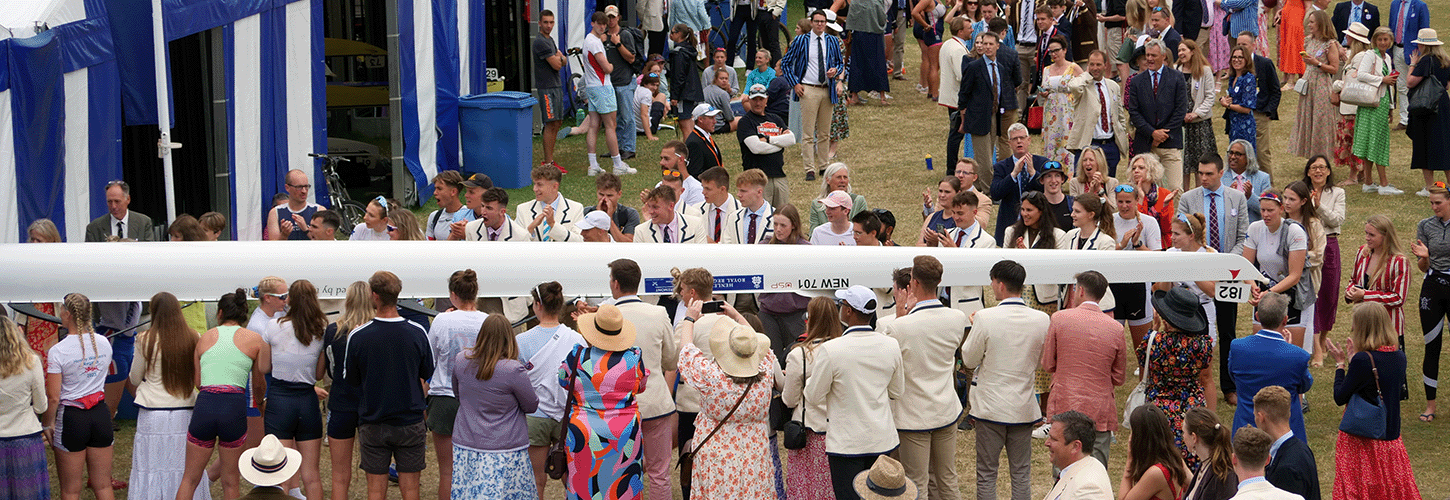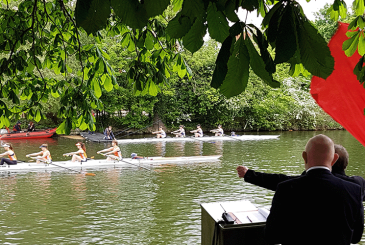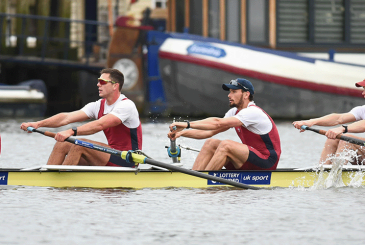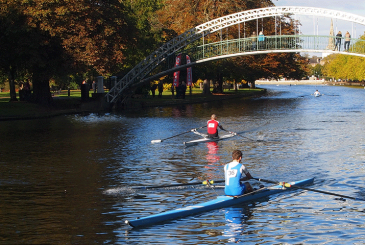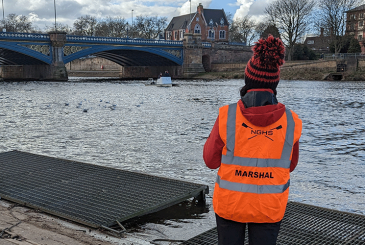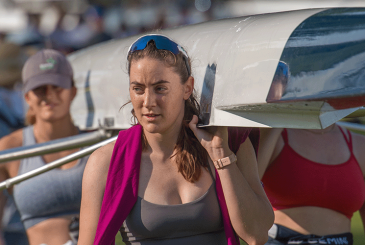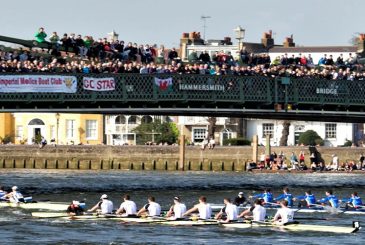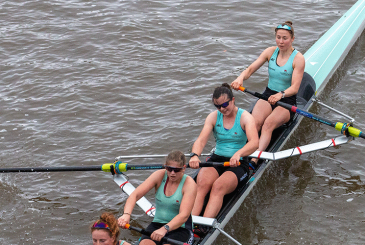Henley Royal Regatta is the world’s most famous river regatta and for many is the pinnacle of the UK racing season. With that comes an enormous amount of pomp, circumstance and unique conditions, which can easily distract competitors who need to focus on rowing their best. Rachel Egan from Junior Rowing News spoke with some of the most experienced athletes and officials in the rowing community about the key things to consider when approaching this historic week.
When you arrive
Boat tents the size of a superstore
The spectacle you encounter before you even set foot in a boat is one of the major features that makes Henley a regatta like no other. Ollie Wynne-Griffith, who won the Ladies Plate at Henley in 2015 with Yale University and now is an established member of the GB Rowing Team, highlighted the boat tents as an extraordinary environment. “Every single crew at the regatta is assigned a rack to keep their boat on,” he said. “This means that 16-year-old schoolboys and girls rub shoulders with Olympic champions. Nowhere else in sports does this happen. I remember being 17 years old and warming up on the ergo next to Hamish Bond and Eric Murray [the famous ‘Kiwi pair’, who dominated the event at the World Championships and Olympic Games from 2009-2016].”

As the week wears on, more and more spectators throng the boat tents to cheer crews as they carry their boats out to race. Anna Bloomer, who races for Oxford Brookes and competed at the Regatta in 2022, also pointed to this as something very special to witness. “The past, present and future members of your boat club clapping your crew out of the boat tents is one of the most incredible feelings,” she said. “It’s a huge team effort to get racing crews out, and it wouldn’t be possible without the support from your coaches and teammates.”
Precious badges
Henley’s unique way of separating the various zones operates on a badge system. You must have your competitors’ badge to get into the boat tents; simply wearing rowing kit isn’t enough. “You need to keep your competitor’s badge very safe,” added Anna. “I recommend putting it on your bag and tucking it into a pocket once you are into the competitor’s zone. Badges are like currency at the Regatta.”
Be aware too that spectators with badges for the Stewards’ Enclosure can access the boat tent area. Just call “Backs” politely if there are spectators standing around socialising on your route from race to pontoon.
Rowing people everywhere
Richard Phelps is one of the Regatta’s senior Stewards and is the incoming Chairman for the event after 2024. “Henley becomes this amazing rowing bubble from the morning of Qualifiers,” he said. “Whether it be in the boat tent, Regatta Cafe or walking down the High Street, you will bump into old friends, rowing legends or the coach of the university/club you want to move to. All wonderful, but massive distractions. Focus on your crew and what you came here to achieve.”
When you’re on the water
The river is a social venue as well as a race course
Once you have boated, the paddle up to the start can be both exciting and nerve-jangling. Whilst preparing for what might be the biggest race of your season, you must navigate pleasure cruisers, cameras, other crews, and a variety of noisy bankside distractions.
“The bounce will always take you by surprise.”
“It’s as busy on the water as it is on the land,” explained Ollie. “Add wash to the already flowing stream, and the water becomes very lively to row on. Whether it’s your first time or your tenth time racing the Regatta, the bounce will always take you by surprise.”

Coping with being in the media spotlight
One of the Regatta’s great strides forward has been the introduction of a market-leading broadcast operation. All the Regatta’s racing is streamed on YouTube and made available for people to follow live around the world. As a result, the course is covered with cameras and even overhead drones. “There are lots of cameras that feel like they might get a bit too close,” said Anna. “There are cameras on the umpire’s launches, on a boat that follows each race for a short distance upstream of Temple Island, drones, and cranes. You’ve just got to ignore them and focus on the race.”
At the start
In essence, the start at Henley is much the same as at any British Rowing affiliated regatta where the umpire in in a launch. Before the actual start, the umpire should always say, “[Club A] [Club B], When I see that you are both straight and ready, I will start you like this: Attention (raises flag), go! (drops flag)”. While they’re doing this, they will keep their starting flag furled.
Note that if the umpire is sitting down, you can relax, and you don’t need to put your hand up to show that you’re not ready. Only put your hand up once they are standing.
When you’re racing
The side-by-side, one-on-one nature of the course transforms racing into a gladiatorial contest that’s flanked by thousands of spectators. Compressing all that drama are the famous booms. “The booms can strike fear into any steersman competing on the course for the first time,” said Ollie. “The first thing to realise though, is that there is actually plenty of space between them. If you’re steering, pick your line off the booms, not the other crew. The start line can be tricky as the natural riverbank does not run straight. Trust your alignment and stick to your point.”
“Don’t save your final push for the second half of the Stewards’ Enclosure”
“The stakeboats can set you up well if you use the ‘Y’ poles,” added Anna. “There are two poles that align when you are sat on the perfect line, which is particularly helpful for coxless boats.”
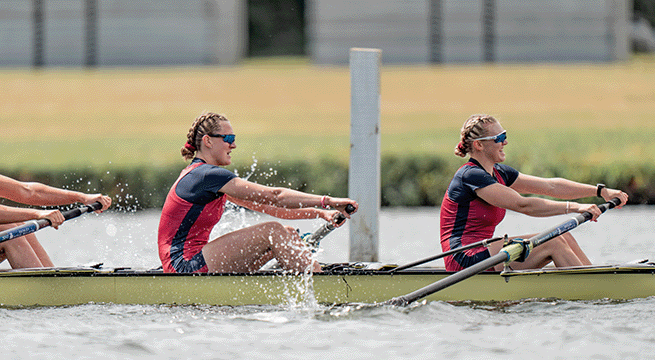
Richard Phelps is also an Umpire at the Regatta and has overseen numerous legendary clashes. “If you are a coxless crew; practice, practice, practice,” he said. “Make sure you’re familiar with both stations from the Start pontoons to the 1/4 Mile. Also, don’t save your final push for the second half of the Stewards’ Enclosure. That’s too late; commit as you leave the Regatta Enclosure.”
When you’re recovering
For those who are destined to go deep into the Regatta, recovery and rest are crucial. The multi-day nature of the event means that the fastest crews may reach on Finals Day with four races already in their legs. “I would recommend 20 minutes of cool down on a spin bike accompanied by plenty of water, some protein and carbohydrates,” advised Ollie. “The quicker you can get this process completed post-racing, the better you will feel in the legs the following day.”
“If you’ve qualified then you’re already at the top of your category of rowing.”
“Over the season, you will have learned how best to optimise recovery for your body,” added Anna. “That is a key part of being an athlete. Don’t change anything just because it’s one of the most important weekends of your season; your body doesn’t know that.”
Above all else though, relish the spectacle. Competing at Henley Royal Regatta means you’re at the very peak of your practice as rower or cox. “First and foremost, enjoy the event,” concluded Richard. “It’s magical and if you’ve qualified then you’re already at the top of your category of rowing.”
Photos: Roesie Percy, AllMarkOne and Alexandra Fraser.


